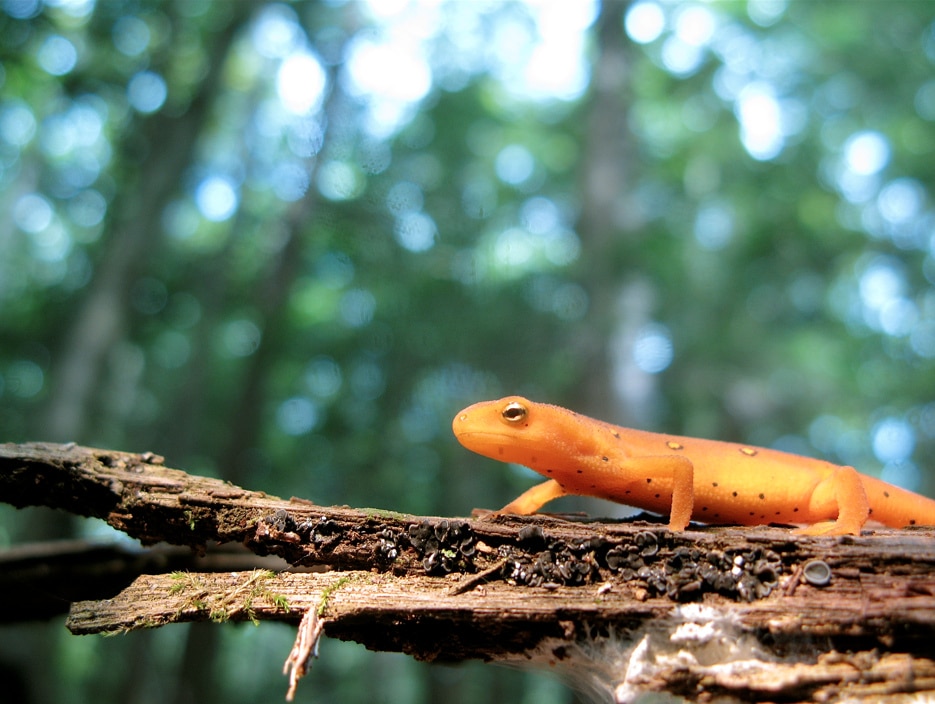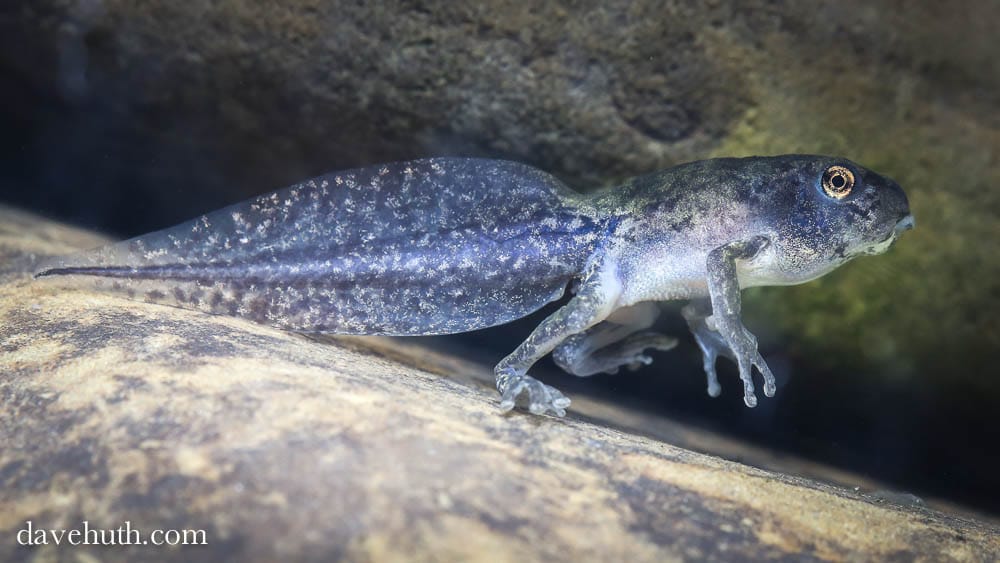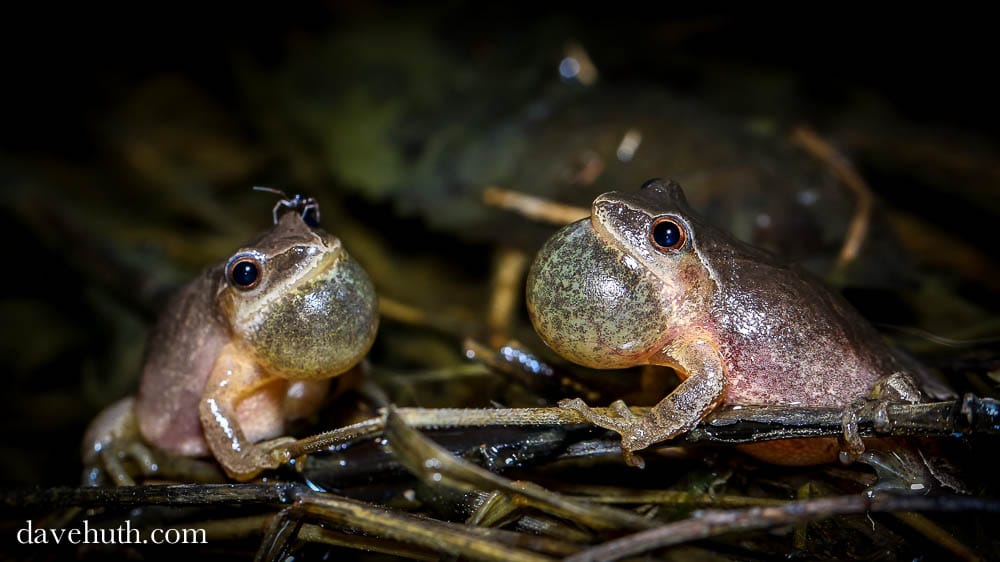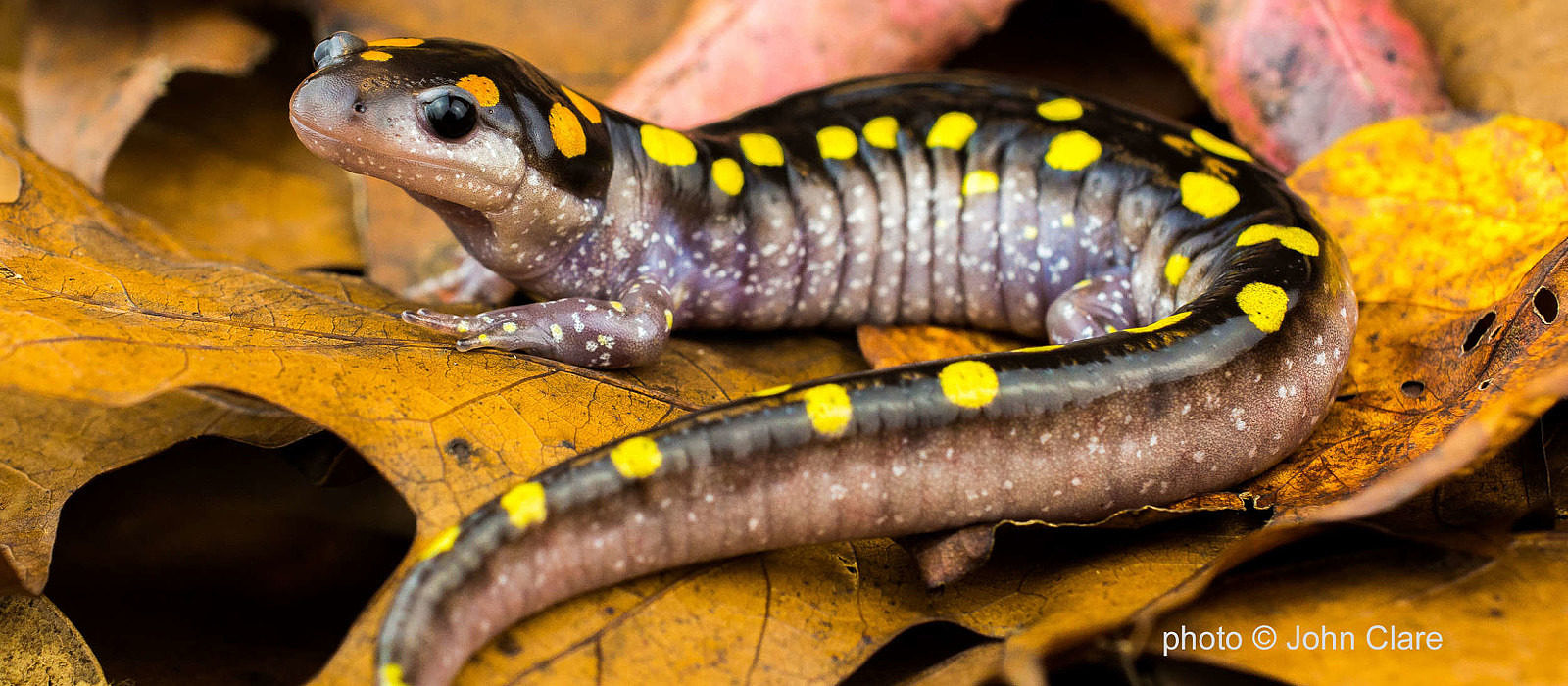Two of our most prominent citizen science programs – the Salamander Crossing Brigades and the Vernal Pool Project – center around amphibians and their habitat. Why this focus on frogs, toads, and salamanders? They have a profound impact on the ecology of Northeastern forests. Their porous skin makes them particularly vulnerable to environmental toxins, so they can serve as “canaries in the coalmine,” if we pay close enough attention. They’re accessible. They’re mysterious. If you’ve ever gazed into the smiling face of a spotted salamander, you know they’re also quite charming. In short, because they’re awesome. Unconvinced? Read on.
1. Salamanders are (bio-)massive.

Love our forests? Thank a salamander. (photo © Dave Huth)
In ecological terms, biomass is defined as the total mass of living organisms in a given place at a given time. Researchers at the Hubbard Brook Experimental Forest in northern New Hampshire found that the biomass of a single salamander species (the Northern redback salamander) was more than twice that of all birds in the forest, even during peak bird breeding season. A Massachusetts study found that the biomass of vernal pool-breeding amphibians in the 53-acre forest surrounding the pool was greater than all the breeding birds and small mammals in the study area, combined. All those amphibians spend a lot of time preying on forest invertebrates and wandering through underground burrows, which in turn affects nutrient cycling, gas exchange, and decomposition rates in the forest floor. Love our forests? Thank a salamander!
2. Amphibian skin is like science fiction alien skin.

A red eft walks through the woods, its sense of purpose and self-importance buoyed by the knowledge that it produces some of the most potent neurotoxins on earth.
(photo © Dave Huth)
The more you learn about amphibian skin, the more it will amaze you. Ever wonder how aquatic newts, who breathe air through lungs like we do, survive harsh New England winters in ice-covered lakes? How do they come up for air with all that ice overhead? They don’t! Instead, they extract oxygen directly from the water by touching it. With their skin.
Even more amazing: some amphibians can sweat poison, and not just any old poison, but some of the most potent neurotoxins known on earth. From their skin. This feat is not limited to tropical rain forest species in far-off lands. In fact, the humble red eft, who you have surely seen wandering through the woods on rainy summer days, produces toxins that, upon entering the digestive tract of certain predators, block signals from the predator’s brain that tell its heart to beat and its lungs to breathe. (Important side note: don’t eat red efts!) If you had amphibian skin, you would be an honest-to-goodness superhero.
3. The amphibian life cycle is the closest thing to sorcery you’ll ever see.

A gray tree frog tadpole, growing legs where there were exactly none before. (photo © Dave Huth)
Amphibians hatch out of eggs as swimming babies that resemble blubbery grapes with tails (frogs and toads) or tiny adults with neck-feathers (salamanders). They live like that for months or years, and then they change into something else entirely. Their body parts completely transform. A tadpole has a mouth and digestive tract completely different in form and function from a frog; in other words, a tadpole’s guts disappear and are replaced by frog guts. Salamanders lose their feathery, external gills, and replace them with internal lungs. They also grow legs where there were exactly zero legs before. When you were a mammal baby, did you grow fully-functional limbs out of your stomach? We didn’t think so.

Wood frogs await the spring thaw in ice cube form.
(photo © Dave Huth)
4. Wood frogs are living ice cubes.
Wood frogs, spring peepers, and grey treefrogs – all common species in our local forests and wetlands – get through the coldest parts of the winter by freezing solid.
Their heartbeat and breathing stop entirely….but they’re not dead. They’re just waiting out the cold, their cell walls protected by natural antifreeze that they manufacture for the express purpose of making it through the winter. When spring comes, they simply thaw out and hop back to life.
5. Spotted salamanders are living solar panels.

Symbiosis in action. (photo © Paul Estes)
If you stumble upon a vernal pool towards the end of May, you may notice that certain spotted salamander egg masses have a greenish glow to them. That green color comes from algae, which are in a symbiotic relationship with the salamander embryos developing inside each egg. The embryos release waste material, which fertilizes the algae. In turn, the algae photosynthesize, producing oxygen for the embryos to “breathe.”
In 2011, scientists made a stunning discovery about the algae-salamander connection: this symbiosis not only takes place in salamander eggs, but also inside salamander cells, and the algae provide the embryonic cells with glucose as well as oxygen. In other words, the algae act as internal power stations, generating fuel for the growing salamanders.
If this sounds strange and fantastical to you, well, that’s because it is. Vertebrates have complex immune systems, which typically reject the intrusion of foreign species. In fact, the solar-powered spotted salamander is the only known vertebrate to contain another species inside its cells. The algae aren’t essential to salamander survival, but they help: embryos deprived of algae have lower survival rates and exhibit slower growth than their green cousins.
6. Frogs have built-in megaphones.

Who needs a microphone when you’ve got a vocal sac? (photo © Dave Huth)
Anyone who has visited a wetland on a May evening knows the awesome acoustic power of the wee spring peeper. Adult peepers are only about an inch long, but they have vocal sacs in their chins that expand with every “peep,” amplifying the intensity of each call. Groups of spring peepers, peeping together in chorus, have been measured at 120 decibels, as loud as a rock concert and louder than a jackhammer!
7. Amphibians regenerate.
If a salamander loses its tail to a predator, the tail will grow back. And not just tails. Also legs, jaws, and internal organs. Also eyeballs. Some salamanders are so good at this that, when threatened by a potential predator, they cut off their own tails by flexing their muscles really hard. Are they magic? No, they’re simply awesome.


